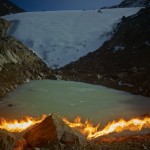Poland Week: Justyna Mielnikiewicz: Ukraine Runs Through It
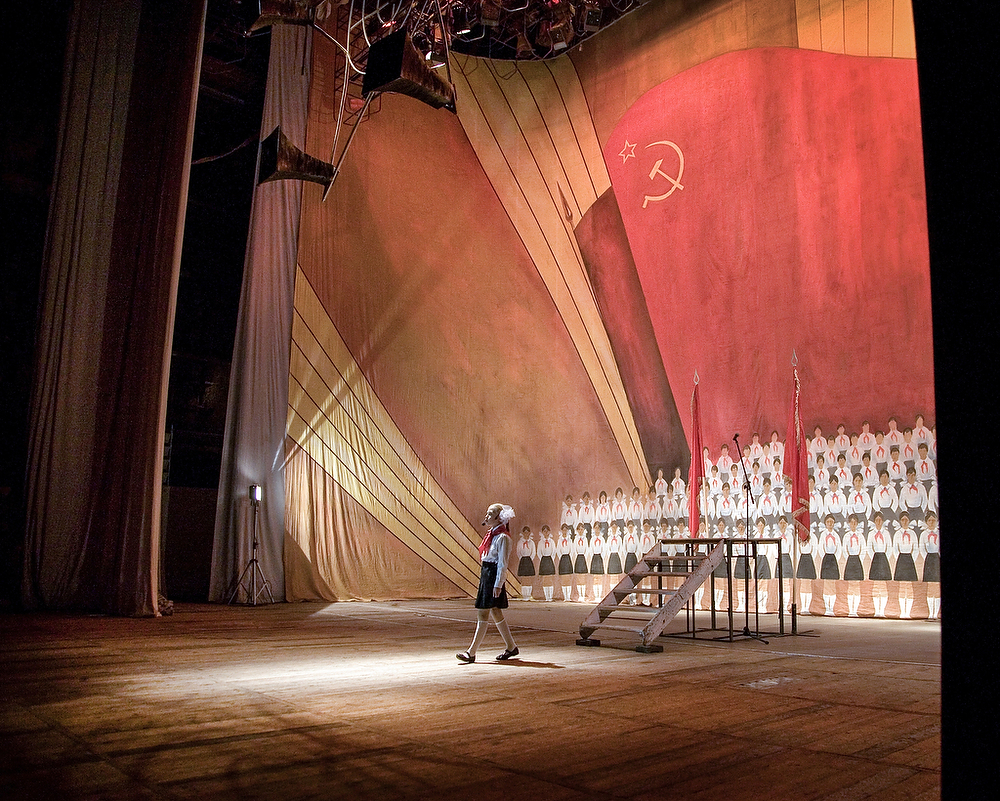
©Justyna Mielnikiewicz, Simferopol, Crimea 2008 Varvara Nikolayenko on the stage in the theater play where she performs a role of the soviet Pioneer. Opening night of the play ÒStalinÕs RoadsÓ was scheduled for the day Ukraine commemorated victims of 1932-1933 Famine . Play presents Stalin as a man who created famine artificially with a purpose to punish Ukrainian anti-Soviet nationalism.During performance police was deployed outside and inside theater to avoid possible clashed with pro-Russian residents of the city-who’s views on the reasons behind the famine are different.
When one attempts to delve deeper into the Polish psyche and concomitantly, Polish photography, the topic often turns to its vastly complicated history with its neighbors to the West (Germany/Prussia) and to the East (Russia and Ukraine). Justyna Mielnikiewicz began her documentary recording of life along the Dnieper River in Ukraine with the intention of avoiding politics by using the river as a metaphorical line of reference. Her original intention was abandoned as the political earthquakes that washed over Ukraine at the time her investigation began in 2014 and beyond became profoundly compelling to explore and to record. A number of additional forces also propelled her to dig deeper into the Ukrainian saga including a family history that mirrored the geo-political ebb and flow between Poland and Ukraine and an unusual perspective presented by her move to Tbilisi, Georgia in 2003 and her coverage of the political and social transformations of the Caucasus region. If you are interested in her book under the same title, you can purchase it through the artist.

©Justyna Mielnikiewicz, July 2015, Dniprovka Village Headless statue of V.Lenin , painted gold stands in the center of the village by Energodar City, where biggest in Europe Atomic Power Station is located , on the bank of Kakhovka Reservoir on Dnieper River.
Mielnikiewicz writes about her intentions with the project in the introduction to the book that ultimately resulted from her efforts:
Witnessing the immediate and profound impact the revolution and the war had on people’s daily lives became an important element of my work, an inherent undercurrent in the river-themed project…the Dnieper has often been portrayed as the demarcation line between the Ukrainian-speaking western part of the country and the Russian dominated eastern lands. Nowadays it’s a contrived perception, even more so now since the Maidan revolutions and the on-going (Donbas) war. The concept of “Little Russia” is buried in the past, replaced by the country, Ukraine.
The same goes for the fabricated issue of divisions based on language. Russian-speaking language rights were used as a pretext to divide people along a reinforced East-West line to instigate unrest…Yet in private and in the media people effortlessly mix both languages while speaking to each other as if there were one tongue.
My book covers a time that started at the end of the Revolution of Dignity, which I believe is one of the most compelling periods in the history of modern Ukraine. Few events since the fall of Communism in post-Soviet space have had such acute international ramifications involving both western Europe and the United States. What began as a protest against a corrupt government led to a new leadership but also war with Russia resulting in a massive transformation of society.
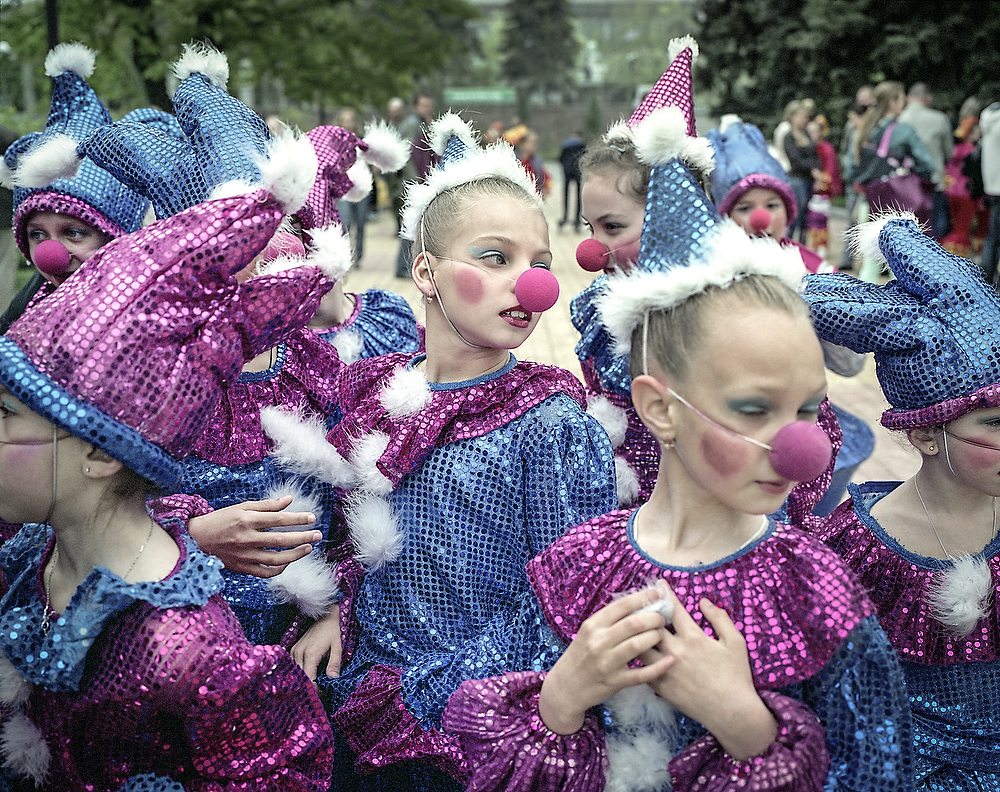
©Justyna Mielnikiewicz, May 1 Celebrations in Donetsk, 2015 , Ukraine School children from Donetsk dressed as clowns getting ready to perform for the public . On May 1 amid the shaky cease fire city of Donetsk celebrated Workers Day , in the city park performers presented for the first time exclusively Russian Folk Dances while non Ukrainian.
Mielnikiewicz’s photography is a constant visual debate between isolation and crowds, between war and peace, between the pastoral and upheaval. While spending time in the midst of the simmering Donbas war between Ukraine and Russia, she photographed in the conflict zone with only a female fixer as her companion. This left her in a potentially vulnerable position as she was undertaking the project independent of any protective cover of a major news outlet or organization. The resulting images provide the viewer with a vivid tapestry of change combined with moments of reflection on the part of those photographed. This constant ebb and flow of images parallels the metaphorical flow of the Dnieper River effortlessly.
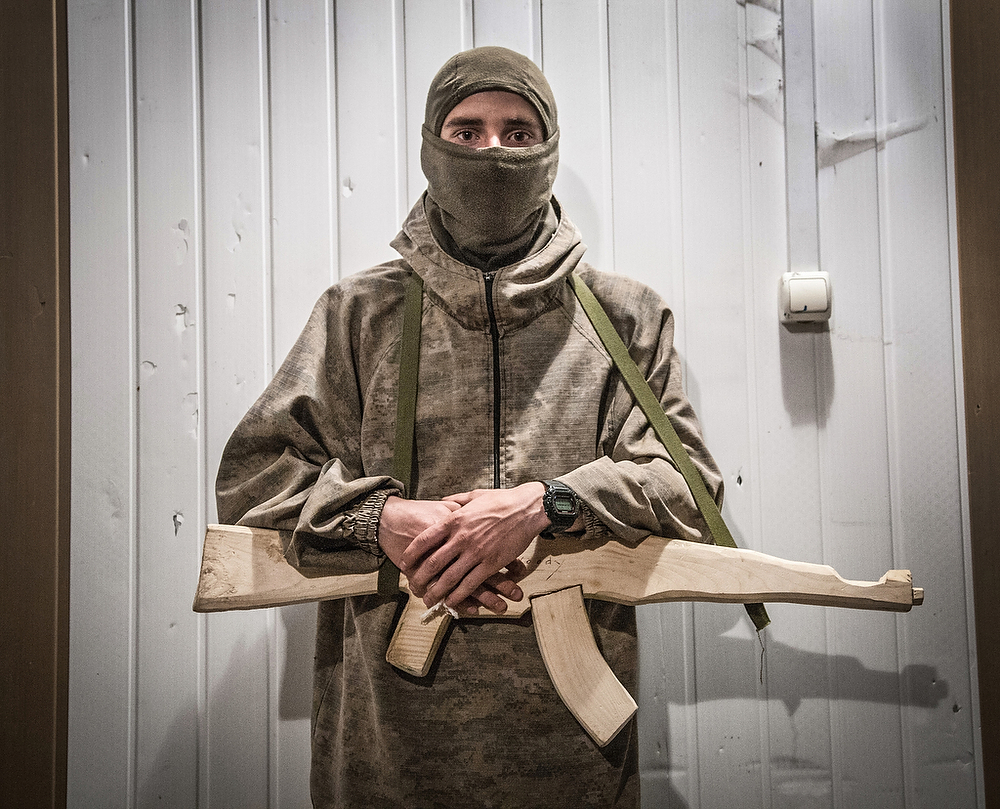
©Justyna Mielnikiewicz, October 2014 , Lviv Area Right Sector training camp in Carpathian Mountains . Man for training they use mock wooden guns . Right Sector which played very important role in Euromaidan Revolution and reminds outside the official structures of either Ministry of Defense or Interior, unlike all the other volunteer Battalions. Because of that it is most accessible military group and many people considering to join the war would go to the Right Sector to undergo the training and possible join the fight with them later on .However not every man who undergoes the training will go to fight. For Russian Propaganda Right Sector became a scare crow , a synonym of West Ukraine nationalism . In reality it was created in Central Ukraine , Dniepropetrovsk Region .While its fighter are considered one of the best fighting on the front line in recent political election Right Sector received minimal support at the level of 3 %.
When asked whether she was more of street photographer or documentary photographer, Justyna claimed that from her perspective “…street photography is more of a skill or craft while documentary connects to other words such as commitment, passion or hard work. Documentary can even be addiction to a story where one story leads to another as a driving force. Street photography is the raw material while documentary is an idea.”
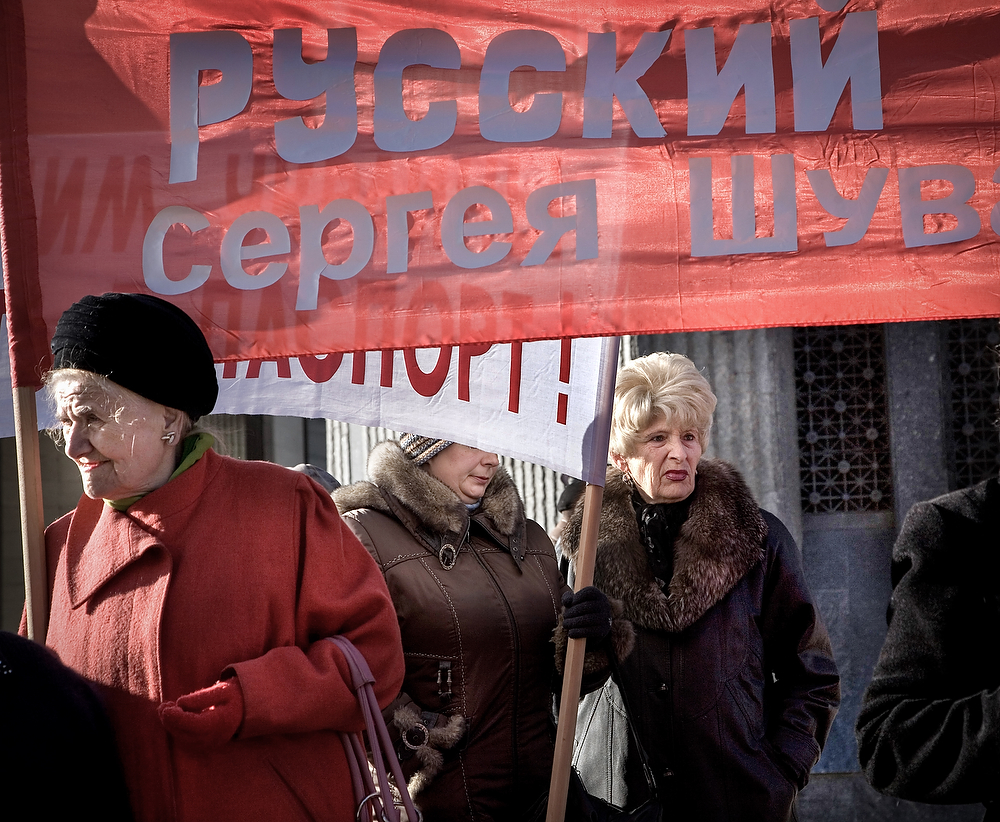
©Justyna Mielnikiewicz, Pro-Russian rally in front of Crimea Parliament . Up to 20 protesters ,mainly pensioners hold the banner with the slogans : “To the Russians of Crimea-Russian Power/Government” or “Stop ethnic genocide of Russian Nation of Ukraine”
She further confesses that her photographic influences stem from a random study of photo books (“any books I can lay my hands on”) including the work of Cartier-Bresson (“for sure he is great, possibly because he was popular and you could find his books everywhere”). Others of her ever-changing influences include the reliable names of Helmut Newton, August Sander, Diane Arbus and Richard Avedon. According to Mielnikiewicz, “Last week, I was looking again at Nicola Lo Calzo’s great project on slavery…the photographers I return to inspire me with a whole body of work, not just one or two good stories. But books are a different story…I rediscover photographers by looking at great books and vice versa…but the book as a form is very unforgiving…I have seen books by photographers that I liked only to realize that not much is there.”
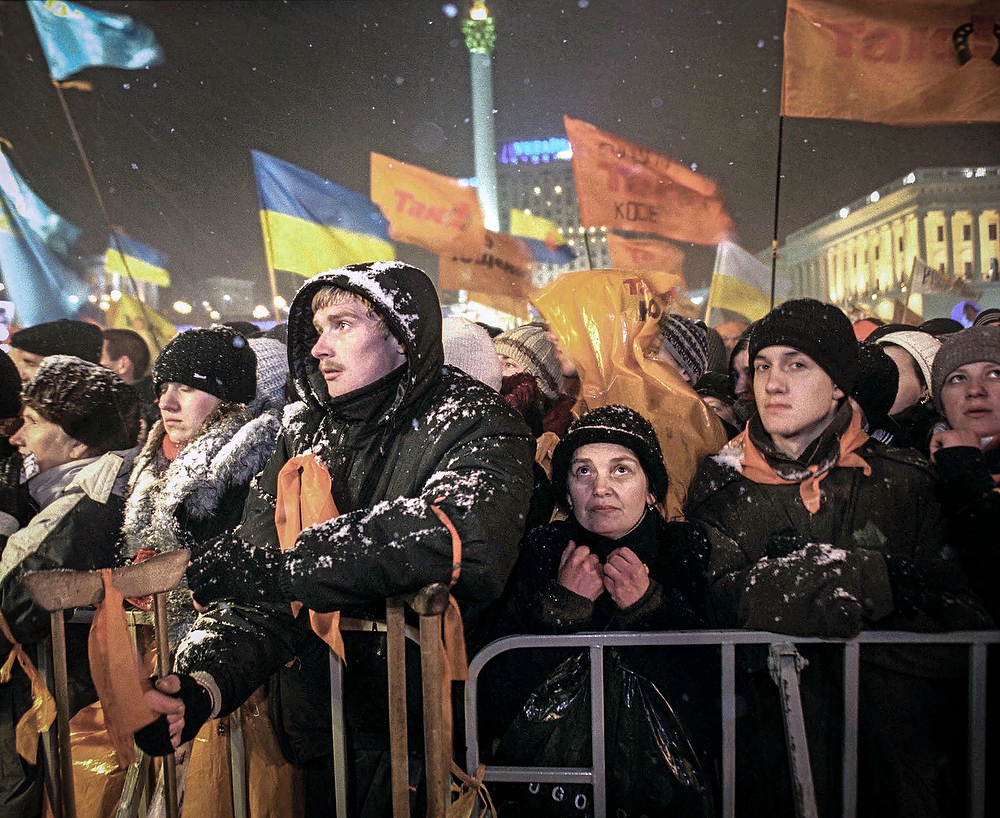
©Justyna Mielnikiewicz, Orange Revolution / Kyiv 24 November 2004 Orange Revolution Supporters listening to leaders speeches-J.Timoshenko and V.Yushchenko are on the stage. Beginning on November 22, 2004, massive protests started in cities across Ukraine: the largest, in Kyiv’ s Maidan Nezalezhnosti (Independence Square), attracted an estimated 500,000 participants.
As for the next items on Justyna’s horizon, one that is nearing fruition is a publication project that will include her series of photo stories dedicated to women of the post-Soviet space. This will include Belarussian brides looking for foreign husbands at marriage agencies as well as the topless protest group, Femen…a kaleidoscope of the female universe east of Poland. The project serves to fill a seventy year information gap during which the Soviet Union was separated from Western ideas and influences while the feminist movement in the West was redefining women’s roles. The work will be finished later this year in a small publication combining Justyna’s photography with historical and editorial stories relating to the theme. Once that is released, she plans to shift gears to a project about an idea relating to the universal human condition instead of a particular country or region. According to Justyna, “…each project is born in such pain and insecurity that I am scared looking at a new one and going through that again…but I will! While being faithful to documentary work, I will experiment with it more than I ever did before.”
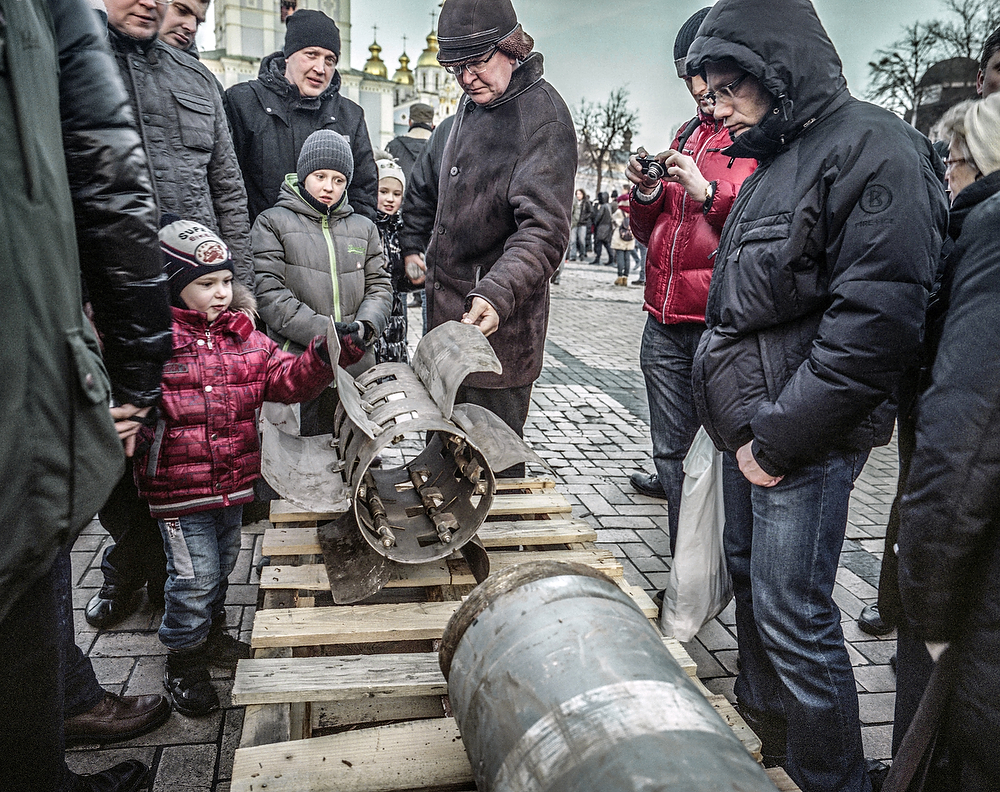
©Justyna Mielnikiewicz, Kyiv, Ukraine, February 2015 Kyiv residents watch armament ( allegedly Russian ) collected on the Front Line of Donbas war and displayed in Ukraine capitol center at the anniversary of Euro Maidan Revolution.
Justyna Mielnikiewicz is an award winning photographer from Poland, based in Tbilisi , Georgia since 2003. Her work is devoted to personal , long term documentary projects published as books addressing social and politial transformation in countries of Central Europe and the Post Soviet space, particularly the Caucasus and Ukraine. Her works have been published internationally by the New York Times, Newsweek, Le Monde , Stern, National Geographic and WSJ – among others. She is a winner of World Press Photo, Canon Female Photojournalist Prize , Caucasus Young Photographer Award by Magnum Foundation , an Aftermath Project Grant and Eugene Smith Fund in 2016 . In 2014 her first book was released : “ Woman with a Monkey- Caucasus in Short Notes and Photographs “ and in 2019 her second book : “ Ukraine Runs Through it “ was shortlisted among the 20 best books by Paris Photo and Aperture. IG: @justmiel
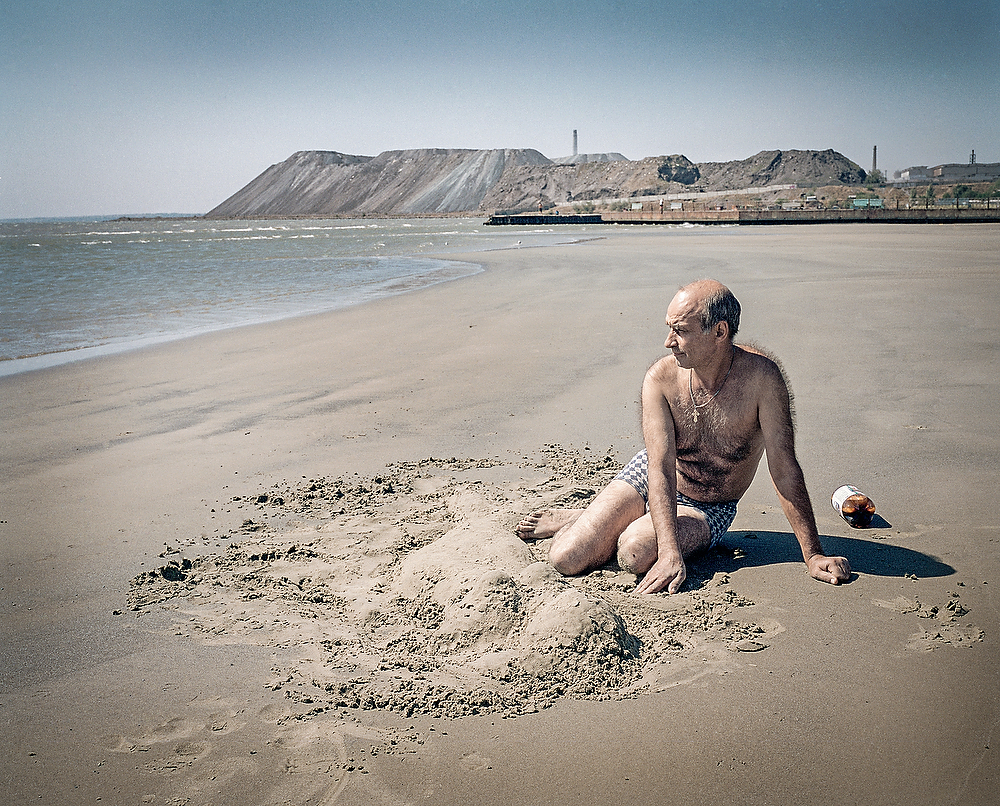
©Justyna Mielnikiewicz, September 2014, Mariupol , Ukraine Valera Starikov (39 ) makes a sand mermaid on the beach in Mariupol city where he fled the war together with his wife . His village was under rebel control and place of his work was under Ukrainian control. Valera did not want to loose his work so each day he bicycled across the frontline between Avdiivka and Yasynivka . After he was caught at the cross fire few times he fled. I become grey from stress -he told me pointing at his hair.
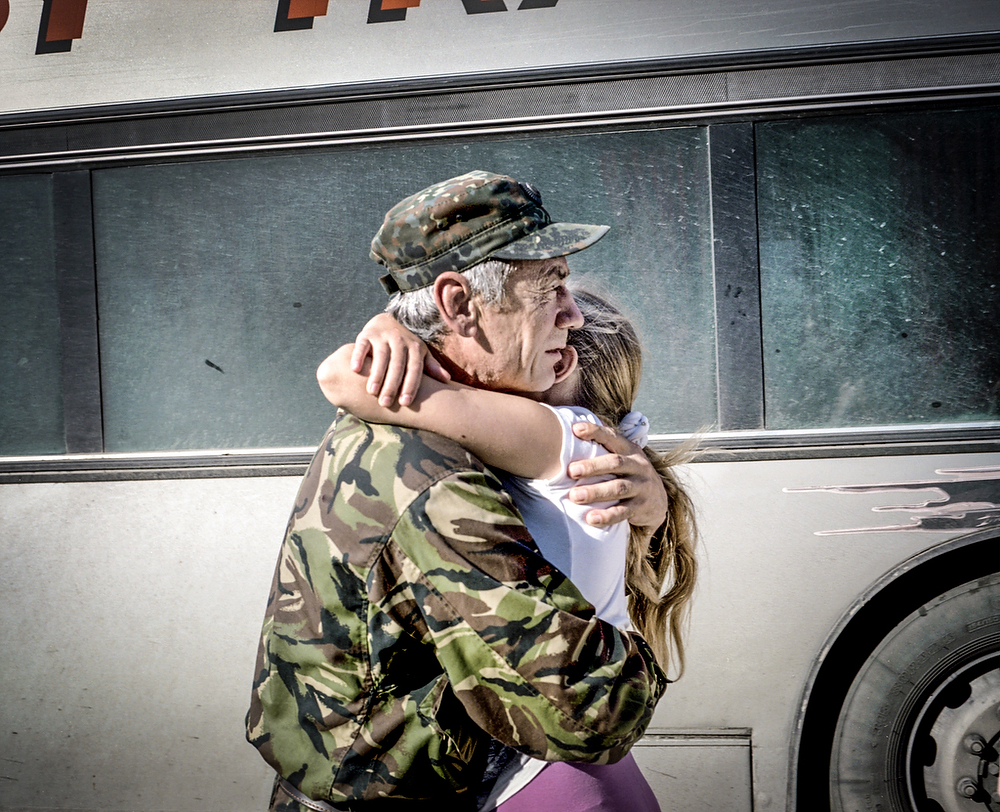
©Justyna Mielnikiewicz, July 2015 , Cherkasy Captain Kasyanenko Nikolay Vasilevich holds his daughter after arriving from the front line back home , where he was for a year. When the war started he was retired from the army but immediately went to sign up as a volunteer to fight . After serving year on the front line he continues to work in the army in his region : “As long as the war will continue I will serve, and what will bring tomorrow only God Decides ” he told me in December 2015.
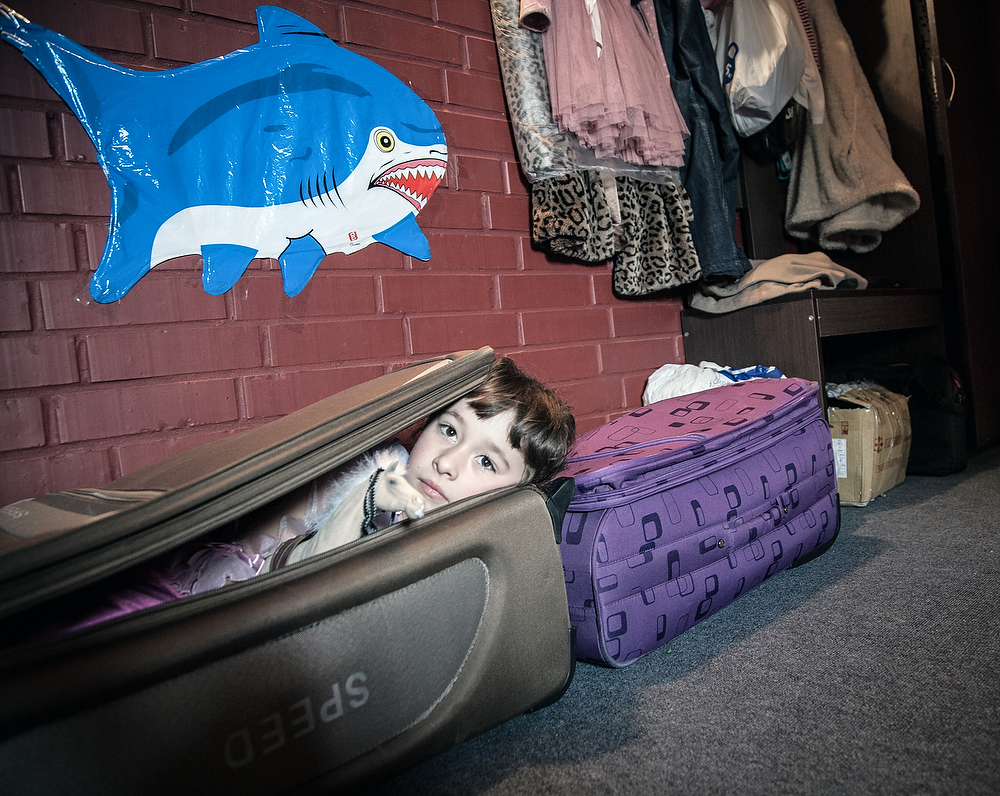
©Justyna Mielnikiewicz, October 2014, Lviv , Ukraine Yaroslava (5 ) was often playing or hiding inside of the suitcase her mother and grandmother brought with them while leaving war torn Donetsk. Stanislav , father of Yarolslava was a Maidan Activist in Donetsk and fled the city already in February of 2014 afraid for his life . His ex- wife and daughter Yaroslava fled later , first to Mariupol in July 2014 than to Lviv . Stanislav friend from Lviv ofered them and group of other IDP’s shelter in the hotel he owned.
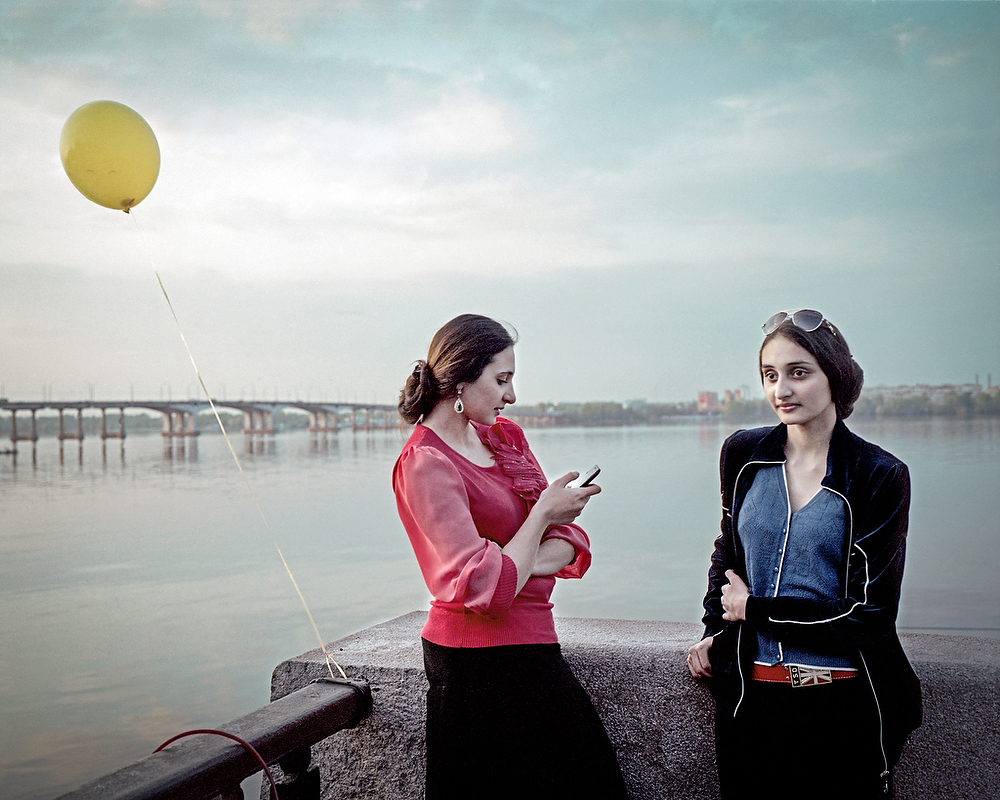
©Justyna Mielnikiewicz, April 2014 , Dniepropetrovsk Two Roma Sisters Ruslana ( 16 ) and Milana (19 ) taking the evening stroll along the Dnieper River. I came there from Donetsk and Slavyansk where war was unfolding and armed rebels terrorized its residents. In Dniepropetrovsk life was quiet , people stroll along the river as war not far away did not affect them directly.
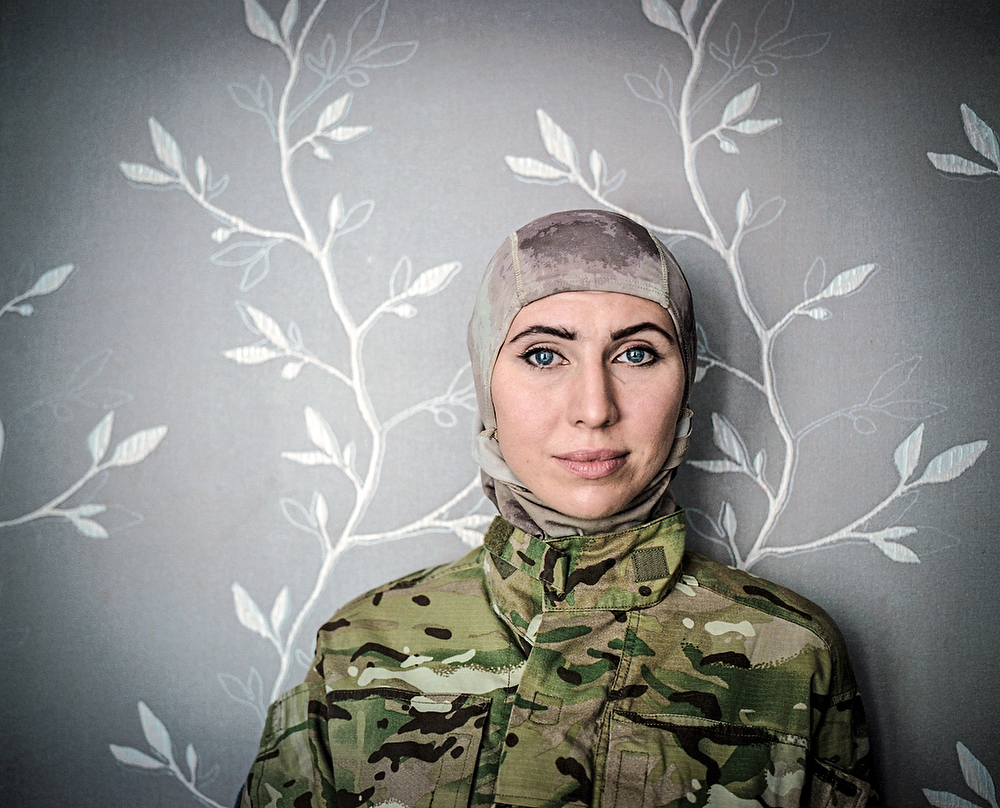
©Justyna Mielnikiewicz, July 2015, Odessa Amina Okuyeva doctor turned soldier poses for the photo in a flat she shares with her mother and son. Amina left war-torn Chechnia (II Chechen war )and moved to Odessa where she studied and become a doctor. She was on Maidan from December 2014 working as a medical volunteer. In that time her husband was in prison accused of the attempt to kill Russian President V. Putin. After Euromaidan revolution he was pardoned and together with Amina joined ” international peacekeeping battalion” of volunteers to support Ukraine in fighting against the pro-Russian insurgency. Presently she is a fighter n the Brigade named after first Chechen president Dzhokhar Dudayev . She also serves as a Brigade Press officer.
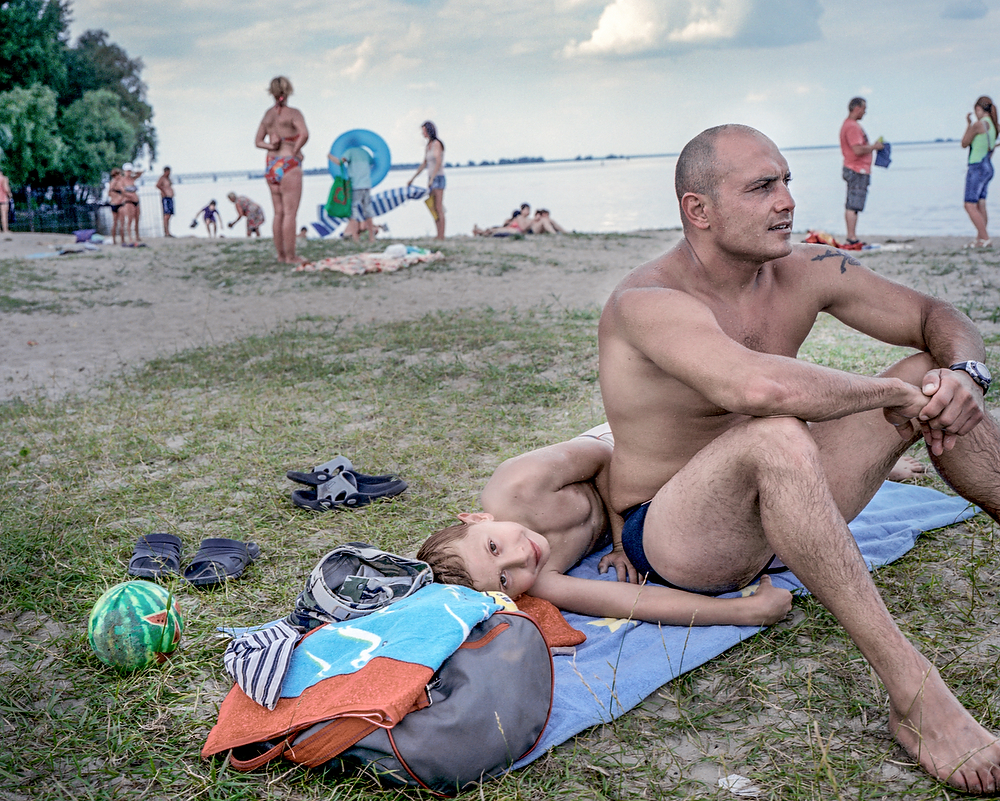
©Justyna Mielnikiewicz, July 2014 , Cherkasy , Ukraine Gyorgg Lakatos with his son Sebastain on a beach in Cherkasy by the Kremenchuk Reservoir on the Dnieper River, Lakatos is a technician in a circus in Italy. His Ukrainian ex-wife works there also, as a bartender. He comes to visit his son in Cherkasy, where he lives with his grandmother while both parents work in Italy. “I like Ukraine but there is no work here, and that is bad,” he said.

©Justyna Mielnikiewicz, April 2015, Donetsk Pro-Russian Rebel Sergey (nome de guerre Fixa) seats nearby Donetsk Airport. His Battalion Somali along with two others took part in fights for the airport- which lasted for months and ended in Jan. 21 . 2015 with Ukrainian defeat. Before the war Sergey used to serve in National Guards of Ukraine than he switched sides . He was wounded in September 2014 during one of the attempts to storm the airport by the rebels.
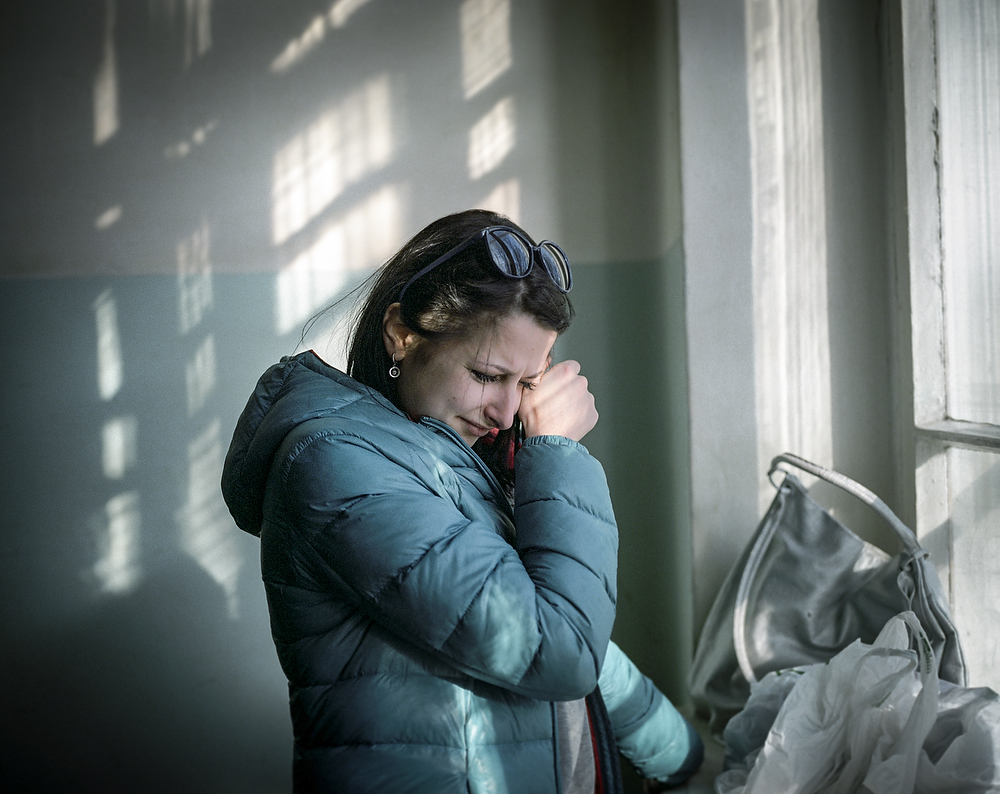
©Justyna Mielnikiewicz, Anna Gvozdiar , in Kyiv Military Hospital , Ukraine 2015 Anna used to be tourism manager and in July 2014 quit her career and devoted herself completely to help wounded soldiers in Kyiv Military Hospital. Each day she volunteered in the hospital helping to take care of the soldiers , providing them with necessities ranging from cigarettes to the wheel chairs . On the photo taken during our interview we stand in hospital back stairs. She cried after talking on the phone with her soldier friends trying to break away from rebel encirclement during the fight for Debalcevo in February 2015 .The information she got was that out of 150 man half died there. Later the number turned to be smaller . In 2016 Anna again started working with tourism but continues to help the soldiers.
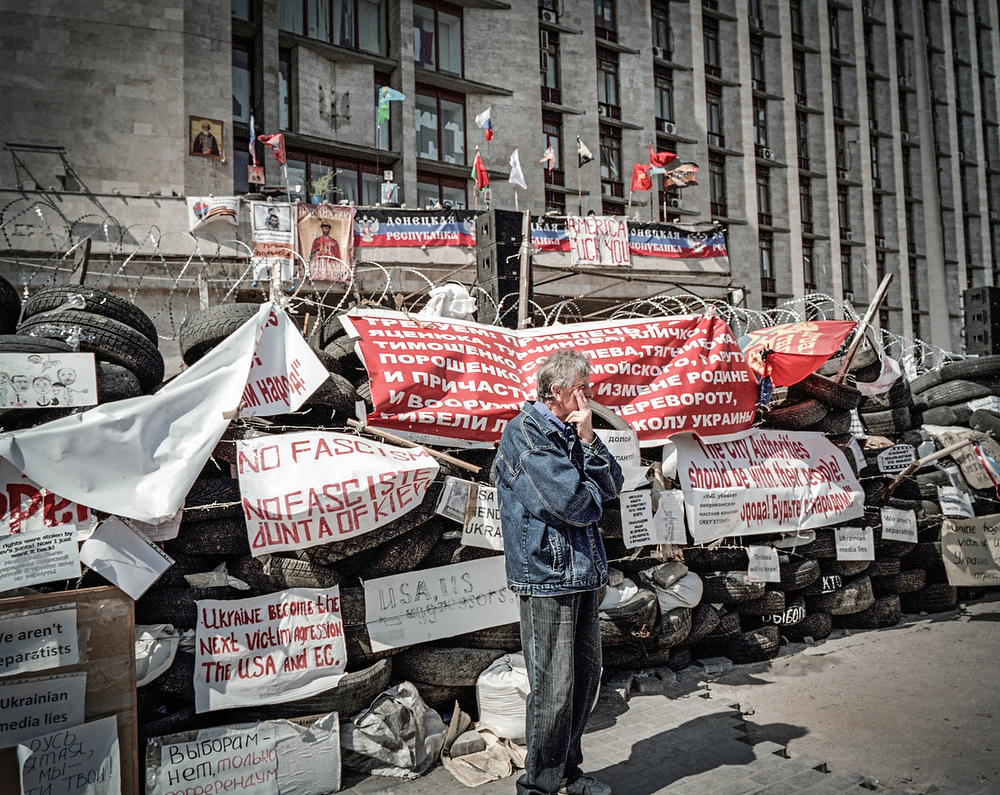
©Justyna Mielnikiewicz, April 2014 , Donetsk Vladimir Alekseyevich (60) stands under the Barricade erected in front of Donetsk Regional Administration Center which was taken under control of rebels few weeks before who declared the region as a People’s Republic of Donetsk . He is a pensioner , former coal miner and Ethnic Russian . His father came here to work in coal mines. His pensions is very low so he works extra as a Street Cleaner .“That is my opinion as a citizen , I do not give a legitimacy to the new Kyiv Government which was chosen illegally, as an effect of ‘coup d’etat’. I am here to demand Ukraine Army withdraw , conducting referendum and federalization .”He believes that they in Donbas will choose the new politicians from their own people and life will be better. “ We will work and things will get better while now we pay for them ( the rest of Ukraine ) “ Armed rebels lived inside the building surrounded by make shift barricades made of old tires as it was done in Kyiv on Euromaidan Revolution. Few hundred people stood in front of the building demanding separation from Ukraine and possibly joining Russia.
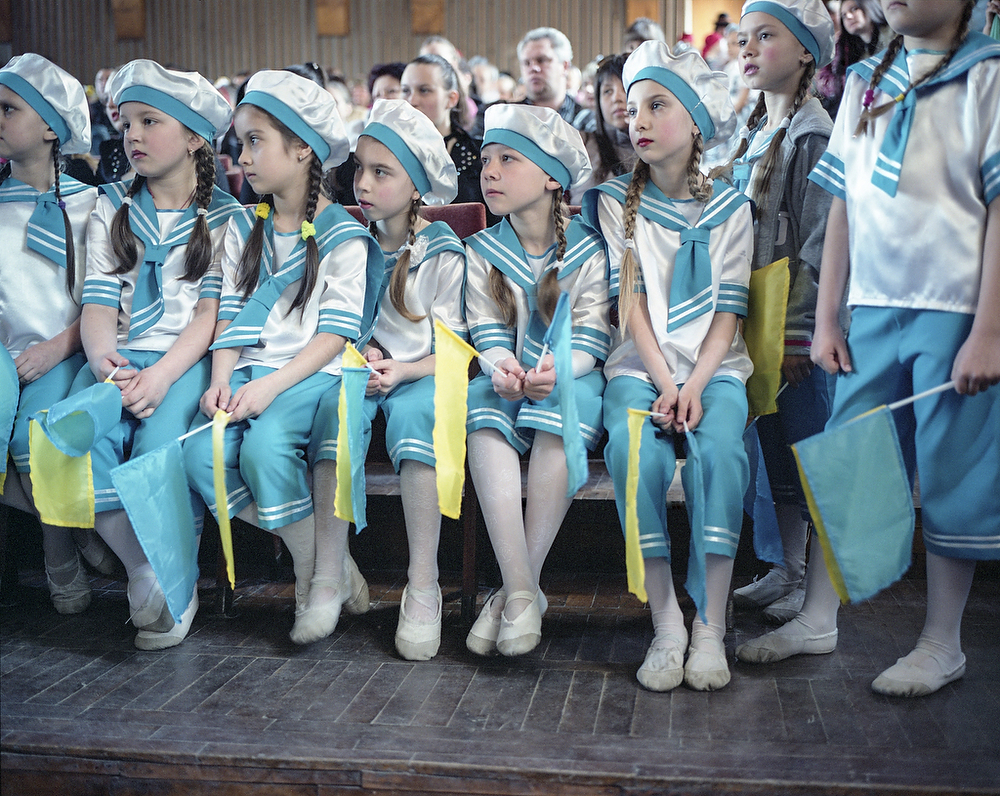
©Justyna Mielnikiewicz, April 2015, Slavyansk Competition of School Dance Groups of Slavyansk and Krematorsk . Year ago Slavyansk became a stronghold of Armed Pro-Russian Rebels and the war effectively started here. In July 2014 Ukrainian Army retook the town . Despite life returning to normal City is still divided in their sympathies towards Kiev and Russia. However residents are sure that they do not want to experience the war anymore.
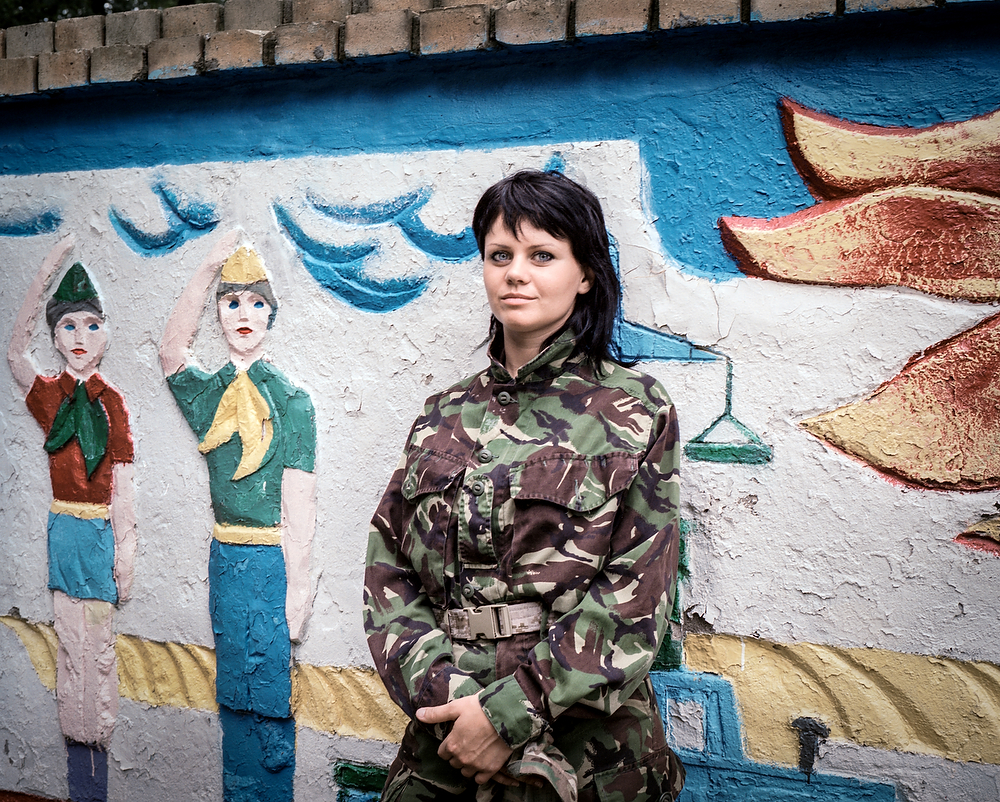
©Justyna Mielnikiewicz, July 2014 , Dniepropetrovsk , Ukraine Masha used to be a hairdresser in Luzhansk. She left her home town when the war started there and joined Donbas Battalion in April 2014 to fight pro-Russian rebels (Luzhansk is one of the rebels strongholds) . Eventually she left the army after Illovaysk battle, however she keeps her uniform and is ready to go back fight in necessary. In 2015 she was elected as a member of City Council of Vinnytsia , but already doubts she can make any substantial changes there.
Posts on Lenscratch may not be reproduced without the permission of the Lenscratch staff and the photographer.
Recommended
-
Earth Week: Simon Norfolk: When I am Laid in EarthApril 27th, 2024
-
Shinichiro Nagasawa: The Bonin IslandersApril 2nd, 2024
-
The International Women in Photo Association Awards: Lorraine Turci: The Resilience of the CrowMarch 16th, 2024
-
The International Women in Photo Association Awards: Rayito Flores Pelcastre: Chirping of CricketsMarch 14th, 2024
-
The International Women in Photo Association Awards: Louise Amelie: What Does Migration Mean for those who Stay BehindMarch 12th, 2024



















